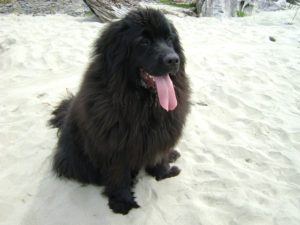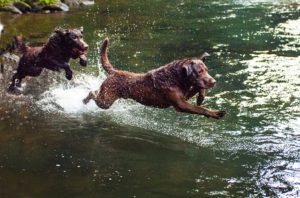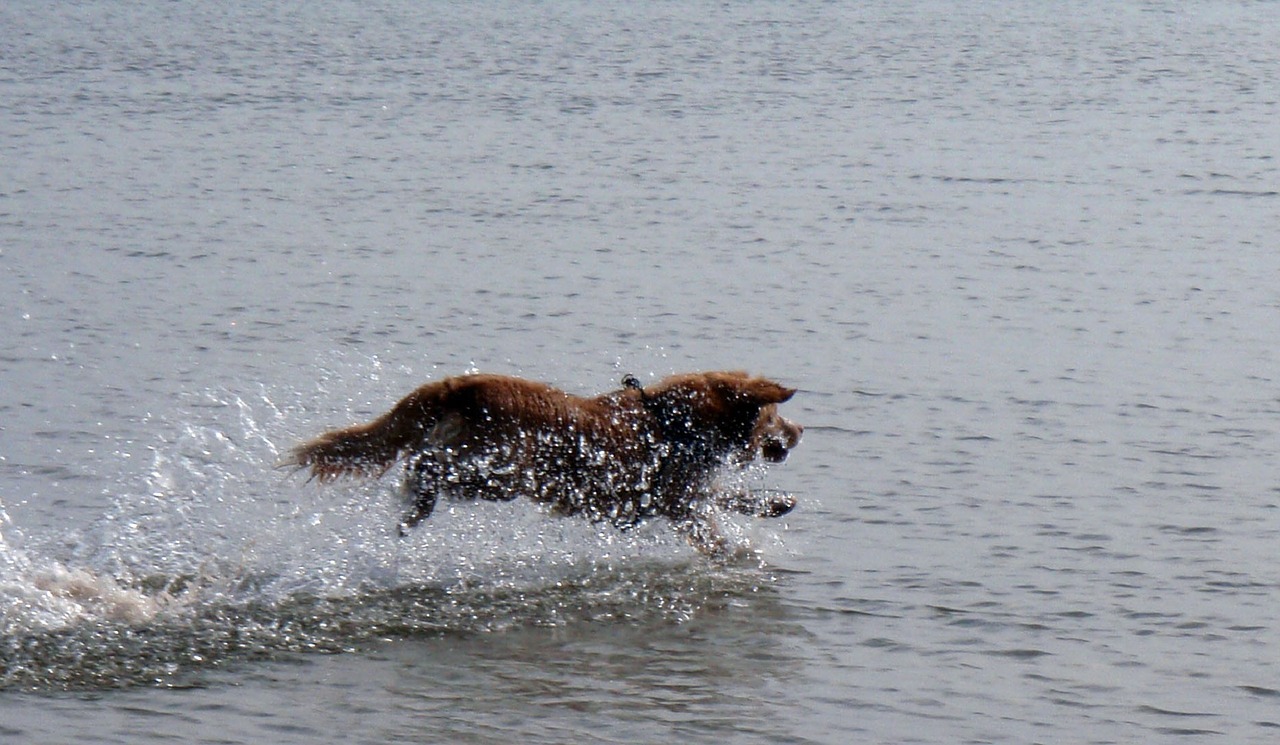Hello, My name is Kearsten and one of the best dogs that I ever owned had webbed feet!
You heard me right. No he was not deformed. His name was Boone and he was half chocolate Labrador and half Dalmatian.
Boone was very fond of the water, whether it be lakes, ponds, or rivers. He would frolic through the water until he was exhausted and then keep going!
My family would often go to the lake to spend the day. Boone would jump over the tail gate and beat us to the water before making several laps. He would chase sticks and kids into the water all day long.
He also loved to chase after ducks and his webbed paws are what helped him to swim out and back to us safely!
What is Webbing?
When we think of webbed feet, we oftentimes automatically think about a duck’s feet.
But did you know that dogs can also have this feature? Webbing on a dog’s feet refers to extra skin that is located between a canine’s toes.
If you take your hand, pick up your dog’s paw, and spread its toes apart, you will be able to see if the dog has excessive skin, just like a duck’s feet.
Unlike a duck’s feet, the paw will only have partial webbing. This excessive skin will connect all of the toes together.
What is the Purpose of Webbing?
Why do some dogs have this webbing, while others do not? Certain breeds of dogs have this unique feature that has been passed down through evolution.
These breeds were more than likely used to hunt and retrieve game for their owners. They developed webbed feet to be able to navigate the diverse terrain and water.
Webbing helps the dog to be able to swim better and more efficiently in different bodies of water.
Just like when you put on a pair of flippers in the water, these webbed feet help a dog to glide on top of the water in order to retrieve objects or even people.
Dogs must be able to paddle longer distances or they have a greater chance of drowning.
Webbed feet are also useful to dogs who are running on muddy areas. Normal feet would sink into a boggy area.
Normal feet would also have a tendency to slip on slick spots. The webbing on their feet helps them to keep from getting stuck in soggy areas and makes them more sure footed.
The Top 10 Breeds of Dogs With Webbed Feet
1. Labrador Retrievers

The Labrador retriever is one of the most recognizable dog breeds in the United States. In fact, it has the most registrations in the American Kennel Club. The Labrador adores the water and will play in any small amount of it, even if it is in its water bowl!
This breed hails from around the waters of Newfoundland. Perhaps an adaptation of being bred near the water, the Labrador has long been used by fishermen and as a duck hunting dog.
It’s powerful webbed feet were first used to help retrieve fish. Today the Labrador is also used by the Coast Guard to help rescue people in the ocean.
The breed has also developed a coat that keeps out the cold in order to navigate cold waters. The Labrador also has a tail that acts as a boats rudder does to help guide it through the water. Its greatest asset is no doubt its webbed feet that help it tread through all forms of water.
2. Golden Retriever
 The Golden Retriever was first developed in Scotland. It is believed to have come from Labradors and a variety of water spaniels.
The Golden Retriever was first developed in Scotland. It is believed to have come from Labradors and a variety of water spaniels.
Because this breed has a natural love for treading water, it is no surprise that they also have webbed feet.
The Golden Retriever is known for its ability to retrieve game such as ducks, geese, and upland game birds. This breed often uses its webbed feet to also help people who are in peril. Golden Retrievers love humans and will not hesitate to jump into water and save a person who is drowning.
3. Newfoundland
 Ironically, the Newfoundland only has partially webbed feet. This large dog breed became famous for using its webbed feet to perform dangerous water rescues in the freezing waters of Canada. Because of its gigantic size, it must have proportionally large webbed paws.
Ironically, the Newfoundland only has partially webbed feet. This large dog breed became famous for using its webbed feet to perform dangerous water rescues in the freezing waters of Canada. Because of its gigantic size, it must have proportionally large webbed paws.
This breed was often a fixture on fishing boats. It could perform rescues because of its ability to swim, its loving nature for humans, its size, and its warm fur coat to keep out the frigid temperature.
Because of its sheer size, the breed is also known for being able to haul up heavy fishing nets on the slick surfaces of boats. The breed has become popular world wide because of its ability.
4. German Shorthaired Pointer
 This incredibly diverse dog is not only a water dog, but also a pointer, and retriever for bird and waterfowl hunters. Its webbed feet reduce the drag the dog feels when in the water.
This incredibly diverse dog is not only a water dog, but also a pointer, and retriever for bird and waterfowl hunters. Its webbed feet reduce the drag the dog feels when in the water.
The German Shorthaired Pointer’s webbed feet are connected to powerful leg muscles that do not tire easily in the water.
The webbing between the toes also aides this breed to be able to fly across muddy ground quickly, in order to reach its quarry. Without the webbed feet, the German Shorthaired Pointer would get stuck in the mud, and possibly break its legs. In addition to its feet, the dog’s coat is waterproof.
5. Dachshund
 Also known as the “weiner” dog, most people do not realize that these well known household pets also have webbed feet.
Also known as the “weiner” dog, most people do not realize that these well known household pets also have webbed feet.
It is hard to imagine these tiny dogs enjoying a long swim. Dachshund‘s used their webbed paws for a different purpose than swimming, however.
Dachshund’s were once a hunting dog. They were bred to be able to hunt down, kill, and retrieve badger’s out of their holes. In order to do this they had to be able to dig down into badger dens. Webbed paws help them to dig faster into a badgers burrow.
6. Weimaraner
 These beautiful “grey ghosts” as some call them, are used for a variety of hunting purposes throughout the world.
These beautiful “grey ghosts” as some call them, are used for a variety of hunting purposes throughout the world.
At one time they chased big game such as mountain lions and bears. In recent history, they have been adapted to be used as waterfowl and bird dogs.
Weimaraner’s use their sleek, athletic bodies, along with their powerful webbed feet, to glide through the water sometimes. Their feet are better used in the marshy areas and through dense brush to retrieve birds however. Often times hunters will have both a Weimaraner and a Labrador as hunting dogs.
7. Otterhound
The Otterhound is a rare breed of canine that has webbed feet. There are very few animals left in the breed, which is why they are so valuable.
Otterhounds would live in the water if they could. They will dive into the water with excitement and will even stick their heads beneath the water.
Its affinity for bodies of water, more than likely, stems from the breeds use in hunting otters and later mink.
Otterhounds also have a long, waterproof coat and their noses are highly sensitive.
These traits in conjunction with its webbed feet made it extremely useful in tracking down otters, in packs, for its owners.
8. Chesapeake Bay Retriever
 The Chesapeake Bay Retriever was developed in Chesapeake Bay around Virginia and Maryland.
The Chesapeake Bay Retriever was developed in Chesapeake Bay around Virginia and Maryland.
The bay is extremely shallow and the water temperature stays rather low, especially in the winter time.
In winter, the water temperature is below freezing. The breed was highly sought after by rich duck hunters in the 19th century because of its ability to withstand the frigid waters.
Chesapeake Bay is in the path of a huge migratory path for ducks and geese. The hunters crossed Newfoundlands and other hounds to form the breed. Because of the crosses that they chose to use, the resulting breed carried down the trait of having webbed feet.
The Chesapeake Bay retriever is very much at home in any type of water. The webbed feet were a feature that helped them become a mainstay in the area.
9. Portuguese Water Dog
 The Portuguese Water Dog hails from Portugal. Fishermen there needed a dog breed that would be a hard worker, athletic and muscular, and could tread the cold sea water. The result was a breed that has a waterproof coat and large webbed feet to be able to swim through harsh conditions.
The Portuguese Water Dog hails from Portugal. Fishermen there needed a dog breed that would be a hard worker, athletic and muscular, and could tread the cold sea water. The result was a breed that has a waterproof coat and large webbed feet to be able to swim through harsh conditions.
The breed was used on many different tasks for the seafaring fishermen. The Portuguese Water Dog was used to herd fish into nets, retrieve lost tackle, and act as a messenger between ships and shore. Fishermen counted on the strong and muscular dogs to be hardworking and seaworthy.
Unfortunately many of the jobs that they were intended for have become obsolete. Today they are still used for sea rescues in cold water however.
The dog pictured is actually Barak Obama’s!
10. Redbone Coon Hound
The Redbone Coon hound’s descendants were brought over from England.
The breed that we see today, developed in the deep south of the United States. Hunters needed a dog that could tree or kill the highly sought after raccoon pelts.
The dog also had to be able to navigate the swampy terrain in Florida and Georgia, and the river bottoms of Alabama and Mississippi. Those breed traits have been passed down through the years.
My grandpa’s coonhounds had to go through river bottoms at night to track down the quick and crafty raccoons.
Raccoons take the dogs through the muddy shores of rivers and will even swim across them to get to its quarry. Webbing is extremely important for this versatile hound dog.
The dogs can not afford to slip or sink down into the mud when they are running full force after a raccoon.
They also have to be extremely powerful swimmers on the off chance that the river current is fast.
How to Keep Dogs With Webbed Feet Happy
Before you buy one of the breeds that have webbed feet, there are a few things to keep in mind. You will probably have to deal with a dog that LOVES to be in the water constantly.
If you do not live on the beach or in the country near rivers, lakes, or ponds, are you willing to deal with a dog who wants to constantly play in its water bowl?
You may also encounter problems with the dog if you have a pool in the backyard. Expect the dog to frequent it. If you do not have a pool, some of these dogs are simply satisfied with a kiddie pool from the store.
Final Thoughts
 Not all dogs are the same. Dogs with webbed feet have been designed to do specific jobs that are water related.
Not all dogs are the same. Dogs with webbed feet have been designed to do specific jobs that are water related.
No mater which one of these breeds that you choose, you will have a great and fun loving companion!
If you have any questions or comments, please leave them below!

